This topic comes up so often, particularly with buyers who are new to Australia, or unfamiliar with the quirks of Victorian auction rules.
The relationship between the auction quote range and the vendor’s reserve is nil.
So many people misunderstand the legal rules though, and in particular the fact that our legislation does not require a vendor to state their reserve until moments before the auction commences.
Given that our legal process enables a Vendor to set their reserve in the minutes before the auction, irrespective of what was quoted, what they were told by their agent to anticipate, and whatever comparable sales were cited, it is not uncommon for a vendor’s reserve to even surprise their agent.
This ‘surprise’ behaviour tends to vary between shifting markets, however.
Under-quoting has been problematic for buyers for years and despite fines and attention from Consumer Affairs in the past years, outlawing the practice continues to be one of the biggest challenges our industry faces. In a desperate attempt to curb the practice (which was formerly adopted with requirement for the quoted price guide to range only ten per cent and to be realistic), Consumer Affairs introduced some changes in 2014.
In the years leading up to this, ‘realistic’ price quoting had became very blurry and the attempts from our regulators were feeble at best. They had only hand picked a small percentage of campaigns that were determined to have misled and deceived the public.
Many would argue that there are multiple reasons why underquoting is such a difficult issue to tackle, and for reasons including, (but not limited to):
– A moving market that is capable of ‘setting a new record’ every Auction Saturday,
– A vendor who changes their mind or decides to increase their sale price expectation on the day
– A market ‘expects’ to add a 10-15% surcharge onto the quoted price (hence, the “if everyone is doing it, we must do it” mentality applies)
– A genuinely fierce auction battle that produces a price tag well in excess of market expectations.
Remaining focused on how the quoting now works is really important for buyers, because the days of “just add another ten per cent” are gone, and in certain markets and locales, underquoting can not only be more rife, but more expected by the local buyer pool
But how do the degrees of underquoting vary in changing markets?
In a hotly contested, seller’s market an underquoted range is far easier to dismiss as “buyer strength”, and if an auction moves fast enough, an auctioneer may not identify to the crowd when the reserve was actually eclipsed by fast bids. But in a slower, buyer’s market, an underquoted range is not easy to hide from if the property passes in to a bidder who’s bid is above the range.
While it may annoy the auction crowd, however, it remains the vendor’s prerogative to sell, or to hold out for a higher offer.
Many auction results can surprise all of us, particularly when a property is particularly special, scarce and running well in the lead up to the auction.
Take this example property in North Melbourne that we challenged the winning bidder for yesterday. Quoted at $2.3M – $2.5M and declared on the market in the haze of bids at some stage slightly above this quote, yet sold for $3.475M. Could have the agent predicted that strong result? And did the vendor decide to set a reserve considerably lower due to their confidence level from the campaign feedback fielded by the agent? Quite likely. But then again, they could have been highly motivated to sell and completely happy with a result sub-$3M.
We will never know if the vendor would have been disappointed with a result at their reserve, or if their expectations were completely exceeded with yesterday’s result.

The sheer strength of the crowd at yesterday’s auction was a sign that this property was indeed something special.

Buyers who feel disheartened when a property price exceeds an agent’s quoted range may have failed doing some important homework. Firstly, working on their own comparable sales is a clever step. If they’ve been watching the market and canvasing a particular genre of dwellings in a given suburb for long enough, they will have as much comparable sales intel as the agents.
Secondly, buyers need to remember that a Vendor can set a reserve price as late as auction day. Agents may be surprised by the reserve or they may not, but the choice is that of the Vendor’s.
Setting a reserve figure is Vendor’s prerogative.
When agents accurately and honestly appraise a property, complete a fair Statement of Information and quote the property accordingly (and as stated on the Sales Authority), they are considered to have fulfilled the marketing aspect of the role.
In a slower, (or buyer’s) market, the best way a buyer can approach their homework is not confined to merely doing their homework and comparable sales analysis. Talking to the agent is powerful too. Unlike a hot sellers market where an agent can’t easily predict the potential strength of multiple buyers, in a slower market, and agent can talk with more confidence about how they predict things could go with the campaign. They are managing less buyers, they likely have a very motivated/committed vendor, and they will possibly be more willing to engage in a pre-auction negotiation.
We can’t underestimate the value of an honest chat about price expectations with the agent.
Being equipped with comparable sales when proposing a chat with the agent is a great first step.
You can find further information here.
And for information on how the Statement of Information works, click here.
And read about how information bias can lead us to the wrong conclusion at times.
Re-written from a former post.
REGISTER TO OUR NEWSLETTER
INFORMATION
CONTACT US
1A/58 ANDERSON STREET,
YARRAVILLE VIC 3013
0422 638 362
03 7000 6026
CATE@CATEBAKOS.COM.AU
